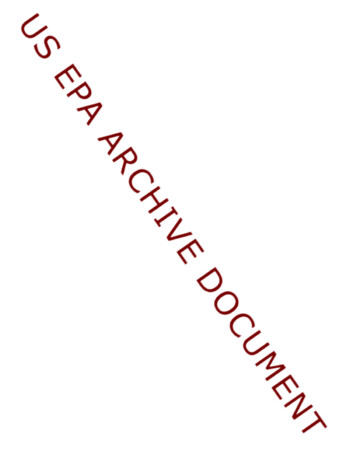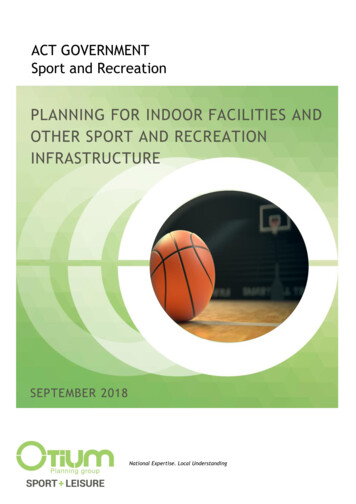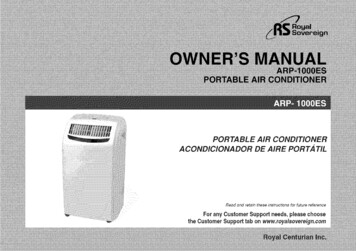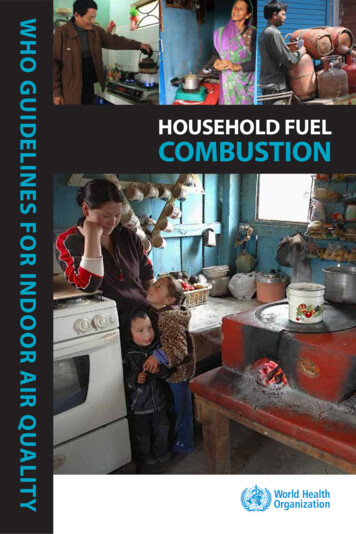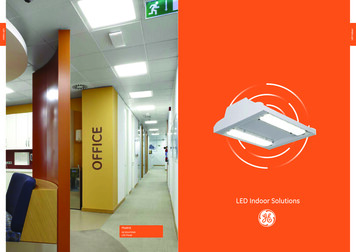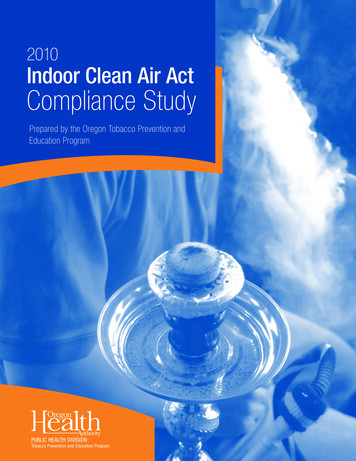
Transcription
2010Indoor Clean Air ActCompliance StudyPrepared by the Oregon Tobacco Prevention andEducation ProgramPUBLIC HEALTH DIVISIONTobacco Prevention and Education Program
Indoor Clean Air Act Compliance StudyNovember 2010Prepared by the Oregon Tobacco Prevention and Education Program1
Table of contentsExecutive summary . 3Background. 5Study methods. 7Study sample . 7Assessment protocol. 8Findings . 10ICAA compliance. 10Certified smoke shops . 10Certified cigar bars . 11Air quality in smoking lounges. 12Description of hookah lounges in Oregon . 16Summary. 18Appendix A. Cigar bar and smoke shop exemption criteria. 19Appendix B. Oregon Counties with hookah lounges in 2008-2009 . 22Appendix C. Youth tobacco use data from Oregon Healthy Teens . 23Appendix D. Summary of research on hookah trends and awareness, October 2010. 32Appendix E. Assessment instrument . 35Appendix F. Letter of introduction. 36Appendix G. United States Environmental Protection Agency Air Quality Index . 37Appendix H. Shisha tobacco flavors . 38Appendix I. Types of hookah lounges. 40Appendix J. Hookah lounge marketing of events . 432
Executive summaryOregon’s amended Indoor Clean Air Act, also referred to as Oregon’s Smokefree Workplace Law, prohibitssmoking in almost all indoor workplaces and public places with the exception of cigar bars and smoke shopsthat are certified by the Oregon Tobacco Prevention and Education Program (TPEP) as meeting statutoryexemption requirements (ORS 433.835 – 433.875). In the summer of 2010, TPEP conducted assessments ofcertified cigar bars and smoke shops to determine compliance with the law. A previous study assessed statewidecompliance among businesses newly required to be smokefree.Key findings from certified cigar bar and smoke shop assessments Compliance with the Indoor Clean Air Act was high among certified cigar bars and smoke shops. Improper signage was the most common compliance issue.Since the amended ICAA took effect on Jan. 1, 2009, a number of new hookah lounges have opened forbusiness in Oregon. Hookah lounges are establishments where customers gather to smoke sweetened, flavoredtobacco (shisha) out of hookahs (water pipes). Meanwhile, the prevalence of hookah smoking increasedbetween 2008 and 2009 among eighth- and 11th-graders (Figure 1 and Figure 2). While increases in cigaretteand smokeless tobacco use also were noted among eighth-graders, these increases were not statisticallysignificant.To better understand hookah lounges, TPEP conducted an observational study and focus groups of youth andparents in the summer of 2010.Key findings from hookah lounge assessments Hookah lounges in Oregon provide a social environment for youth and young adults to smoke flavoredtobacco. The majority of hookah lounge customers appear to be between the ages of 18 and 25. Marketing materials collected online and in person at hookah lounges are targeted to younger audiencesand glamorize hookah use. Focus group findings highlight the accessibility of hookah lounges to youth younger than 18 andwidespread social acceptance of hookah use among high school students.3
4
BackgroundOregon’s amended Indoor Clean Air Act (ICAA) took effect on Jan. 1, 2009, prohibiting smoking in bars,bowling centers and bingo establishments in addition to almost all other indoor workplaces and public places(ORS 433.835 – 433.875). The ICAA permits smoking inside certain cigar bars and smoke shops certified bythe Oregon Tobacco Prevention and Education Program (TPEP) as meeting the exemption criteria set forth inthe ICAA (Appendix A).The first aim of this study is to assess compliance with the ICAA among certified smoke shops, certifiedcigar bars and potential indoor smoking lounges.1 TPEP conducted observations at certified cigar bars andcertified smoke shops to assess compliance with the exemption criteria. TPEP also conducted observations atpotential indoor smoking lounges to assess compliance with the smoking prohibition. In addition, TPEPcollected data on air quality, customer demographics and types of products for sale. A previous study assessedstatewide compliance with the ICAA among businesses newly required to be smoke free.2The second aim of this study is to describe hookah lounges in Oregon. After the ICAA took effect, TPEPreceived increasing numbers of smoke shop certification applications from hookah lounges (Figure 3). Hookahlounges are establishments where customers gather to smoke sweetened, flavored tobacco (commonly called“shisha”) out of hookahs. A hookah is a type of water pipe believed to originate from the Middle East, butwhich now is marketed widely in North America and elsewhere around the globe. Hookahs typically are tall,narrow glass pipes with one or more flexible hoses through which tobacco is smoked. The tobacco is heated bycharcoal in a ceramic bowl located atop the pipe’s stem, and the resulting smoke is cooled by the water beforebeing inhaled. According to the World Health Organization, hookah smokers may inhale as much smoke duringa typical hookah session as a cigarette smoker would inhale from 100 cigarettes.3Oregon surveys show hookah smoking increased significantly from 2008 to 2009 among eighth- and 11th-gradestudents living in the five counties known to have hookah lounges in 2009 (Appendix B). As shown inAppendix C, in these five counties, hookah smoking more than doubled among eighth-grade girls from 2.4percent in 2008 to 5.2 percent in 2009. Among 11th-grade girls in the five counties, hookah smoking increasedfrom 9.8 percent in 2008 to 15.4 percent in 2009, which exceeds the rate of cigarette smoking (13.3 percent).Other forms of youth tobacco use did not increase significantly during that time period. Together, these datahighlighted a need to better understand hookah lounges in Oregon.1The ICAA does not provide TPEP with the authority to proactively identify businesses that may be violating the ICAA.This study is for assessment purposes only; no enforcement actions resulted from this study, and no businesses areidentified by name. ICAA violations can be reported online at w.who.int/tobacco/global interaction/tobreg/Waterpipe%20recommendation Final.pdf.5
In addition to the observational study, TPEP conducted focus groups among youth, young adults and parents.TPEP also interviewed community leaders in Oregon and tobacco prevention professionals in other states(Appendix D).Figure 3. Smoke shop certification applications, December 2008-September 20106
Study methodsStudy sampleThis study was conducted during summer 2010. The study sample, which was identified in July, does notinclude businesses that opened or applied for certification after that date. The study sample is described in Table1. The sample included certified smoke shops (n 15) and certified cigar bars (n 8), as well as other potentialindoor smoking lounges identified through certification application records, business name registrations,4Internet searches, and reports from county tobacco prevention programs (n 15). Although 15 cigar bars havebeen certified, seven were excluded from the study because six of them no longer allow indoor cigar smokingand one is on a private golf course.The following definitions explain the difference between the types of smoking lounges in Oregon. Refer toAppendix A for ICAA exemption criteria.4 Certified cigar bars – Businesses that have applied for and been granted an exemption from the ICAAbecause they met the cigar bar certification criteria. Certified smoke shops – Businesses that have applied for and been granted an exemption from the ICAAbecause they met the smoke shop certification criteria. Cigar lounges – Certified cigar bars, certified smoke shops and non-certified shops that operate cigarsmoking lounges. Hookah lounges – Certified smoke shops that operate as hookah lounges and non-certified hookahlounges. Non-certified, potential smoking lounges – Businesses identified as possibly allowing indoor smoking ina lounge-type environment. This includes businesses with pending smoke shop certificationapplications, businesses that have been denied smoke shop certification, businesses identified by countytobacco prevention programs, and businesses identified through the Secretary of State’s Business NameRegistry and Web searches. Tobacco retail stores – Certified smoke shops and non-certified tobacco stores that sell tobacco, but donot operate as smoking lounges.www.filinginoregon.com/index.htm7
Table 1: Study sample (n 38)Description of business based on observationDescription of business basedon certification statusCigar lounges(n 14)Hookahlounges(n 10)Tobacco retail stores(n 14)Certified cigar bars (n 8)800Certified smoke shops(n 15)564Non-certified, potentialsmoking lounges (n 15)1410Assessment protocolAssessments were conducted between July and September 2010. The assessment instrument (Appendix E) wasdeveloped and piloted by two trained observers. The assessment instrument is a half sheet of paper thatincludes: ICAA exemption requirements; items for sale and in use; marketing materials; and demographiccharacteristics of business patrons. Observers also measured indoor air quality using a TSI SidePak AM510Personal Aerosol Monitor (“SidePak”).Tobacco retail stores and cigar lounges were assessed on random days of the week at random times duringoperating hours. Hookah lounges were assessed Friday and Saturday between 9:30 p.m. and 1 a.m.Observations at tobacco retail stores and cigar lounges lasted an average of 10 minutes. Observations at hookahlounges lasted an average of 30 minutes because observers generally had to be seated and make a purchase inorder to gain admittance.Observers brought a letter of introduction from TPEP explaining the study to present to businesses upon request(Appendix F). Observers were prepared to identify themselves, provide the letter of introduction from TPEPand explain the study upon request. They did not otherwise volunteer any information.Exterior assessmentThe observers assessed whether the required “no minors” and “smoking allowed” signs were posted on theentrances and exits of certified smoke shops and certified cigar bars. They assessed whether certified smokeshops were stand-alone businesses. Observers also documented the presence of enclosed outdoor smokingareas, defined by the ICAA as a space between a floor and a ceiling enclosed on three or more sides bypermanent or temporary walls or windows, exclusive of doors or passageways.8
Interior assessmentObservers documented the times at which they (observers) entered and exited the business, as well as thenumber of smoking instruments they observed to be in use upon entry, and every 10 to 15 minutes until theirexit from the business.Non-certified businesses were assessed for compliance with the indoor smoking prohibition. Certified smokeshops and certified cigar bars were assessed for compliance with the relevant ICAA exemption criteriaincluding: available seating, presence of a humidor, gambling availability, tobacco sales and use, smokinginstrument sales, and use and alcohol availability.In order to characterize the businesses in more detail, additional information was collected on number anddemographics of patrons, number and demographics of employees, and food and nonalcoholic beverageavailability. The observers – one male and one female, both of whom are younger than 26 – also noted whethertheir own identifications were checked, as well as the identifications of patrons.Observers used a TSI SidePak AM510 Personal Aerosol Monitor (SidePak) to measure indoor air pollutionfrom tobacco smoke. The SidePak monitor measures PM2.5 particulate matter, which is less than 2.5 microns indiameter (about 1/30th the diameter of a human hair). Particles of this size are produced by combustion and areassociated with premature death from heart and lung diseases. The SidePak draws in air through a tube every 60seconds. The SidePak was concealed in a bag or purse with the tube extended outside of the bag; concealing theSidePak in this manner does not affect measurements. Because the SidePak creates a whirring noise whileoperating, air pollution measurements only were taken in establishments with enough ambient noise to obscurethe sound of the monitor (n 22).Marketing assessmentObservers collected shisha tobacco menus, event fliers and other marketing materials from hookah loungesduring the assessment visits. Pictures and marketing materials also were collected from public websites,including social marketing websites such as Facebook and MySpace. Samples of these materials are included inAppendix G.9
FindingsICAA complianceCertified smoke shops and certified cigar bars were in compliance with most of the exemption criteria. Notableexceptions included the smoking of non-cigar tobacco products inside cigar bars and the lack of appropriate “nominors” and “smoking allowed” signage at both types of establishments.Indoor smoking was observed at four of the 16 non-certified, potential smoking lounges; all four were hookahlounges. One non-certified, potential smoking lounge appeared to function as a cigar lounge, based on employeecomments, but no smoking was observed at the time of the assessment. One additional non-certified, potentialsmoking lounge was allowing hookah smoking outside in anticipation of smoke shop certification.Certified smoke shopsAs shown in Table 2, all of the certified smoke shops were stand-alone businesses, with no gambling or alcoholon the premises, and had posted “No minors under the age of 18” signage. However, 10 of the 15 certifiedsmoke shops lacked signs stating that smoking is allowed on the premises.Table 2. ICAA compliance among certified smoke shops (n 15)n (% observed incompliance)Stand-alone business15 (100%)Signs at each entrance and exitstating persons younger than 18are prohibited from entering thepremises15 (100%)Signs at each entrance and exitstating that smoking is allowed onall or some of the premisesDoes not sell or provide alcoholfor on-premises consumptionDoes not offer video lotterygames, social gaming or bettingon premises5 (33%)15 (100%)15 (100%)10
Certified cigar barsAs shown in Table 3, all of the certified cigar bars were compliant with rules pertaining to no gambling, seatingcapacity, presence of a humidor, and Oregon Liquor Control Commission licensing. However, some cigar barswere noncompliant on three of the exemption criteria: the smoking of non-cigar tobacco products was observedat one cigar bar; three lacked signage prohibiting minors under the age of 21; and half lacked signs stating thatsmoking is allowed on the premises.Table 3. ICAA compliance among certified cigar bars (n 8)n (% observed in compliance)Signs at each entrance and exit stating personsyounger than 21 are prohibited from entering thepremises5 (63%)Signs at each entrance and exit stating that smokingis allowed on all or some of the premises4 (50%)Has a humidor on the premises8 (100%)Has a full, on-premises alcohol sales license8 (100%)Maximum seating capacity of 408 (100%)Does not offer video lottery games8 (100%)Only cigars being smoked (no other tobaccoproducts)7 (88%)11
Air quality in smoking loungesObservers measured fine particle (PM2.5) air pollution inside 17 smoking lounges. According to theEnvironmental Protection Agency:“Health studies have shown a significant association between exposure to fine particles and prematuredeath from heart or lung disease. Fine particles can aggravate heart and lung diseases and have beenlinked to effects such as: cardiovascular symptoms; cardiac arrhythmias; heart attacks; respiratorysymptoms; asthma attacks; and bronchitis. These effects can result in increased hospital admissions,emergency room visits, absences from school or work, and restricted activity days. Individuals that maybe particularly sensitive to fine particle exposure include people with heart or lung disease, older adults,and children.” (www.epa.gov/pmdesignations/basicinfo.htm)The United States Environmental Protection Agency Air Quality Index identifies PM2.5 concentrations rangingfrom “good” to “hazardous” and the corresponding Health Advisories that are issued when outdoor PM2.5concentrations reach these levels (Appendix G). Peak and average PM2.5 measurements are displayed in Tables4a and 4b.Air quality in hookah lounges (n 10)Observers measured PM2.5 in all 10 hookah lounges where indoor smoking was observed (six certified smokeshops and four non-certified businesses). Peak and average PM2.5 for each business are displayed in Tables 4aand 4b. Hookah lounges had a median peak PM2.5 of 161, which is classified as “very unhealthy” according tothe EPA Air Quality Index (Appendix H). This level of air quality would trigger a health alert advising that“everyone may begin to experience more serious health effects.”Air quality in cigar lounges (n 7)Observers measured PM2.5 in seven of the cigar lounges, but were unable to complete inconspicuousmeasurements in the other seven lounges due to the noise produced by the SidePak. The following descriptionincludes five certified cigar bars and two certified smoke shops operating as cigar lounges. Cigar lounges had amedian peak PM2.5 of 24, which is classified as “moderate,” according to the EPA Air Quality Index (AppendixH). This level of air quality is “acceptable; however for some pollutants there may be a moderate health concernfor a very small number of people who are unusually sensitive to air pollution.”12
Table 4a. Peak PM2.5 in smoking lounges (n 17)EPA Air Quality IndexHealth advisoryHazardousHealth warnings of emergency conditions. The entire population ismore likely to be affected. 251Very unhealthyHealth alert: Everyone may experience more serious health effects.151-250UnhealthyEveryone may begin to experience health effects; members ofsensitive groups may experience more serious health effects.Peak PM2.5Business type750Hookah lounge220Hookah lounge177Hookah lounge172Hookah lounge166Hookah lounge163Cigar lounge156Hookah lounge117Hookah lounge83Hookah lounge76Hookah lounge67Hookah lounge66Cigar lounge64Cigar lounge24Cigar lounge18Cigar lounge9Cigar lounge*4Cigar lounge*66-150Sensitive groupsMembers of sensitive groups may experience health effects. Thegeneral public is not likely to be affected.41-65Moderate 16-40Good 15Air quality is acceptable; however, for some pollutants there maybe a moderate health concern for a very small number of peoplewho are unusually sensitive to air pollution.Air quality is considered satisfactory, and air pollution poses little orno risk.*Only one lit smoking instrument at the time of the observation13
Table 4b. Average PM2.5 in smoking lounges (n 17)EPA Air Quality IndexHazardous 251Unhealthy66-150Sensitive Groups41-65Moderate 16-40Good 15Health advisoryHealth warnings of emergency conditions. Theentire population is more likely to be affected.Everyone may begin to experience health effects;members of sensitive groups may experience moreserious health effects.Members of sensitive groups may experiencehealth effects. The general public is not likely to beaffected.Air quality is acceptable; however, for somepollutants there may be a moderate health concernfor a very small number of people who areunusually sensitive to air pollution.Air quality is considered satisfactory, and airpollution poses little or no risk.Average PM2.5 Business type576Hookah lounge72Hookah lounge72Hookah lounge67Cigar lounge57Hookah lounge53Hookah lounge38Cigar lounge35Hookah lounge30Hookah lounge27Hookah lounge23Hookah lounge22Hookah lounge17Hookah lounge13Cigar lounge8Cigar lounge7Cigar lounge*2Cigar lounge**Only one lit smoking instrument at the time of the observation14
Air quality in tobacco retail storesFor comparative baseline measurements of indoor air quality, air quality measurements were taken at fivetobacco retail stores where no indoor smoking was observed.The following description includes five nonsmoking, non-certified establishments. Tobacco retail stores had amedian peak PM2.5 of 2, which is classified as “good,” according to the EPA Air Quality Index, and comes withno health advisory (see Table 5).Table 5. Air quality in tobacco retail stores (n 5)*EPA Air Quality Health advisory Peak PM2.5 Average PM2.5 Type of businessIndexGood 15Air quality isconsideredsatisfactory, andair pollution poseslittle or no risk.43Tobacco retailer22Tobacco retailer21Tobacco retailer11Tobacco retailer11Tobacco retailer* No lit smoking instruments at the time of the observation15
Description of hookah lounges in OregonThe average hookah lounge in the observational study had seating for 65 patrons (20-150). In comparison, cigarlounges had an average seating capacity of 16 (1-40), while tobacco retail stores had an average seating capacityof one (0-6).Forty percent of the hookah lounges checked the identifications of the observers and 60 percent checked theidentifications of other patrons. About half of patrons were female (44 percent) and 77 percent appeared to bebetween the ages of 18 and 24. For comparison, cigar lounges averaged five patrons at the time of observation;few patrons were female (6 percent) and none appeared to be between the ages of 18 and 24.Hookah lounges had an average of three employees working at the time of the assessment. Of the employees, 29percent were female and about half appeared to be age 18 to 24. For comparison, cigar lounges had an averageof one employee working at the time of the assessment. One of four observed cigar lounge employees werefemale and none appeared to be ages 18 to 24.Every hookah lounge observed required a minimum hookah purchase for each patron, usually a strict twoperson-per-hookah rule. Hookah rentals cost between 11 and 17 per session, with the option of purchasing ashisha tobacco refill for between 5 and 7. Two hookah lounges had a minimum drink requirement and onehookah lounge required a cash cover charge to enter the lounge.Patrons order the flavor of shisha tobacco that they would like from a menu at the front counter. Table 6 showsexamples of candy-, fruit-, coffee-, cocktail- and sexually themed shisha flavors. Additionally, many hookahlounges had “house blends” created by employees that tended to have risqué names. Examples of hookahlounge shisha tobacco menus are in Appendix H. All shisha flavors contained tobacco; there were no tobaccofree or “herbal” options observed for sale at any hookah lounge. Other items for sale included packaged candyand snacks, soda pop and energy drinks (e.g., Red Bull). In addition, some hookah lounges sold stash cans(storage containers with false bottoms or tops in the shape of soda or beer cans) and K2, also known as “Spice,”which is a packet of incense coated with a synthetic chemical that mimics a marijuana high when smoked.5After ordering, patrons sit in the lounge area. An employee delivers and sets up the hookah, and in some cases“starts” the hookah by taking the first inhalation of smoke. Throughout the smoking session, employees replacethe coals on top of the hookah to keep the shisha burning.5The Oregon Pharmacy Board banned K2 in October 2010 after the hookah lounge assessments were 6
Table 6. Examples of observed shisha tobacco e blendsSkittlesBanana splitRum honeyAppleAmericanoTriple XOrgasmBubble gumBig melonsStrawberrymargaritaCappuccinoSex on thebeachAlcoholismCotton candyPeaches andcreamVanillamojitoMocha latteTurning trixxAIDS in aboxObservers identified three general categories of hookah lounges: bar/club, house party and intimate(Appendix I). The majority of patrons of the bar/club and house party lounges appeared to be ages 18 to 24.The two largest lounges were in the bar/club category. They featured seating for more than 100 patrons, dancefloors, DJs and risqué theme nights. Appendix J shows samples of marketing for hookah lounge events.Three lounges were in the house-party category. They were in small buildings, such as converted homes. Theyfeatured seating for 50 to 70 patrons, video gaming systems (e.g., Nintendo Wii, Microsoft Xbox) and multiplelevels and rooms with couches and futon beds. Although the observers did not see any alcohol being providedor openly consumed, empty beer cans and broken glass were observed in one lounge of this type, and anotherhad patrons openly discussing being intoxicated.Five lounges were in the intimate category. They featured seating for 10 to 20 patrons, tables, chairs, couches,televisions and wireless Internet access. They had fewer patrons on average, and most appeared to be ages24 to 35.17
SummaryCompliance rates with the ICAA were high among businesses certified exempt from the indoor smoking ban.Improper signage was the most common compliance issue. Based on these assessments, certified businessesshould be reminded about signage required by the ICAA.Regardless of certification status, indoor air quality in smoking lounges is poor. With the exception of two cigarlounges in which only one cigar was lit at the time of the observation, peak PM2.5 ranged from a moderate tohazardous health risk. As currently written, the smoke shop exemption in the ICAA allows for unlimitednumbers of new smoking lounges to open, posing a serious health hazard for employees and customers alike.Smoking lounges, not tobacco retail stores, are the primary type of business operating under the smoke shopexemption. The vast majority of smoke shop applications have been from hookah lounges, and this studyindicates that the trend will continue. At least four hookah lounges are operating without smoke shopcertification. At the same time, survey data show that hookah smoking has increased among adolescents, andfocus group data indicate widespread social acceptance of hookah smoking among adolescents and youngadults. Hookah lounges target young people with a party-like atmosphere featuring candy- and cocktail-flavoredtobacco, which is an addictive product associated with heart and lung diseases. Hookah lounges make tobaccouse more easily accessible and attractive to young people.18
Appendix A. Cigar bar and smoke shop exemption criteriaOregon Indoor Clean Air Act433.835 Definitions(1) “Cigar bar” means a business that:(a) Has on-site sales of cigars as defined in ORS 323.500;(b) Has a humidor on the premises;(c) Allows the smoking of cigars on the premises but prohibits the smoking of all other tobacco products inany form including, but not limited to, loose tobacco, pipe tobacco, cigarettes as defined in ORS 323.010 andcigarillos as defined by the Oregon Health Authority by rule;(d) Has been issued and operates under a full on-premises sales license issued under ORS 471.175;(e) Prohibits persons under 21 years of age from entering the premises and posts notice of the prohibition;(f) Does not offer video lottery games as authorized under ORS 461.217;(g) Has a maximum seating capacity of 40 persons;(h) Has a ventilation system that is certified by the assistant to the State Fire Marshal described in ORS476.060 for the jurisdiction in which the cigar bar is located as adequate to remove the cigar smoke in the cigarbar and vents the smoke from the cigar bar in a manner that prevents the smoke from entering any otherestablishment; and(i) Requires all employees to read and sign a document that explains the dangers of exposure to secondhandsmoke.5) “Smoke shop” means a business that:(a) Is primarily engaged in the sale of tobacco products and smoking instruments, with at least 75 percent ofthe gross revenues of the business resulting from such sales;(b) Prohibits persons under 18 years of age from entering the premises;(c) Does not offer video lottery games as au
3 Executive summary Oregon's amended Indoor Clean Air Act, also referred to as Oregon's Smokefree Workplace Law, prohibits smoking in almost all indoor workplaces and public places with the exception of cigar bars and smoke shops

